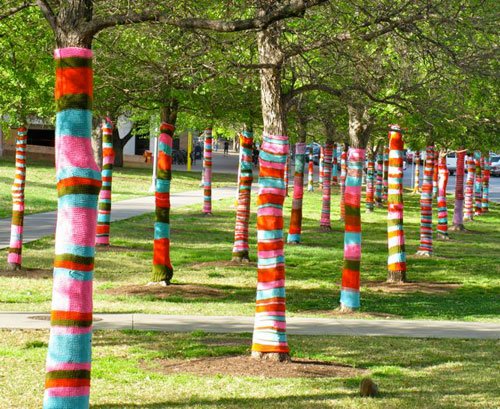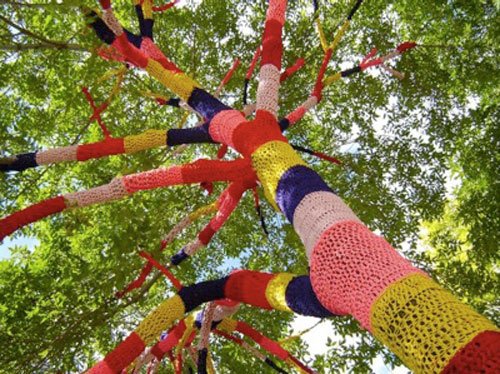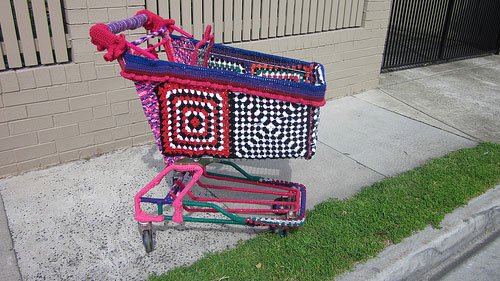A Punch in the Eye
 There is jewellery out there that is subjectively unappealing … and then there is jewellery that is unquestionably and irrefutably downright ugly. In the case of the former, there might be someone out there who might like it, in the case of the latter: if you like it, there’s something wrong with you. As one of my friends and I like to say: there’s good bad design, and just plain bad.
There is jewellery out there that is subjectively unappealing … and then there is jewellery that is unquestionably and irrefutably downright ugly. In the case of the former, there might be someone out there who might like it, in the case of the latter: if you like it, there’s something wrong with you. As one of my friends and I like to say: there’s good bad design, and just plain bad.
An item designed with sound principles in mind* – composition, balance, scale, colour, medium – and executed well may nevertheless be unappealing to some. Beauty is in the eye of the beholder after all. Sometimes it’s a punch in the eye. But when a product is crafted without consideration of these fundamental criteria, then all bets are off. In face of a fan we can presume the ugly product in question is a mirror of their bad taste.
Beauty is in the eye of the beholder after all. Sometimes it’s a punch in the eye.
A newsletter from a jewellery supplies website Land of Odds appeared in my inbox this morning, and when I clicked on it I saw an image of an extremely ugly necklace. “Gosh that’s ugly,” I thought, and then saw that it was in fact advertising the annual Ugly Necklace competition that the website runs. This is an interesting challenge; as the competition promoters state: ‘It ain’t easy doing ugly, or as my momma says, “Ugly is as Ugly does.”’.
A talented and skilled artisan is not naturally given to creating something ugly. However, there are some who have managed to overcome this natural diffidence.
Although these first three examples of ugly necklaces are undeniably frightful, there is some coherence to their design: the materials used bear some relationship to one another. The last necklace owes its overall ugliness to the juxtaposition of its diverse materials. These separate components broken apart would be repellent enough, but combined into one disparate and ghastly whole, this necklace enters into another realm of ugliness entirely.
Scroll down and you be the judge.
* Click here to read about fundamentals of good jewellery design
All images from Land of Odds Ugly Necklace competition

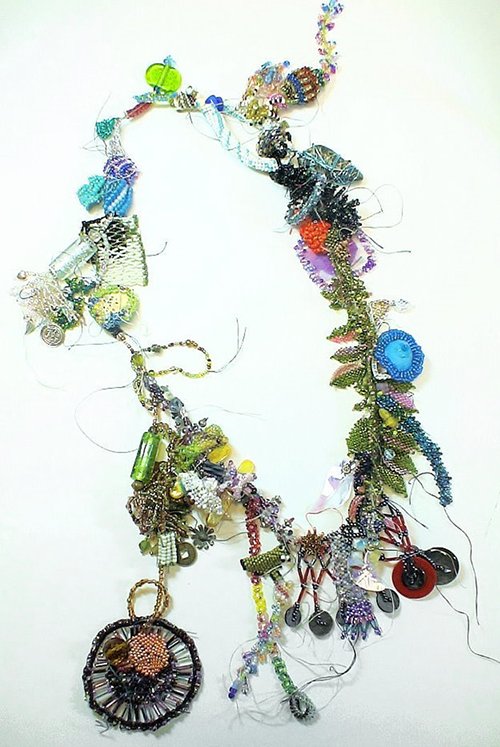
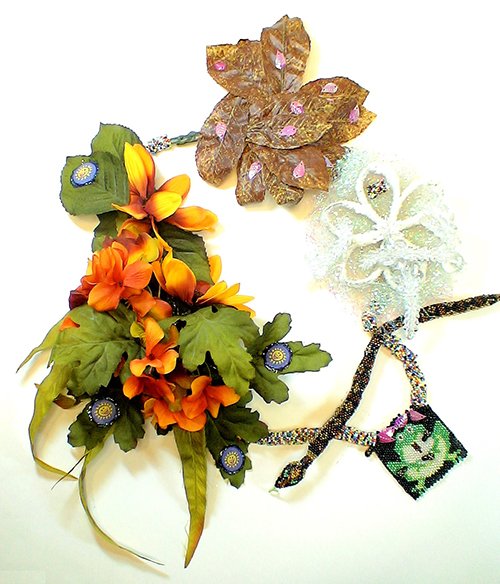
Love Knots
 Boutonnière :: Tinto 1848 // C-Type Plate // No flash
Boutonnière :: Tinto 1848 // C-Type Plate // No flash Vintage 1920s lingerie pin from Beautiful ReignI often make jokes about ‘researching’ stories on Etsy as opposed to merely wasting time window-shopping, but on the odd occasion it’s true. One discovery in the store Beautiful Reign while on a search on 1920s boudoir caps led to some craft-making. I thought these ribbon flowers were very pretty, but never bought them. After they were sold, I decided I could very likely make my own.
Vintage 1920s lingerie pin from Beautiful ReignI often make jokes about ‘researching’ stories on Etsy as opposed to merely wasting time window-shopping, but on the odd occasion it’s true. One discovery in the store Beautiful Reign while on a search on 1920s boudoir caps led to some craft-making. I thought these ribbon flowers were very pretty, but never bought them. After they were sold, I decided I could very likely make my own.
 You’re A Peach :: Tinto 1848 // C-Type Plate // No flashIt’s not so easy to find modern ribbon made from silk, or even rayon, and I decided to use inexpensive polyester for my prototype. I purchased 2 metres of 6mm ribbon in a peachy colour, a typical 1920s lingerie shade.
You’re A Peach :: Tinto 1848 // C-Type Plate // No flashIt’s not so easy to find modern ribbon made from silk, or even rayon, and I decided to use inexpensive polyester for my prototype. I purchased 2 metres of 6mm ribbon in a peachy colour, a typical 1920s lingerie shade.
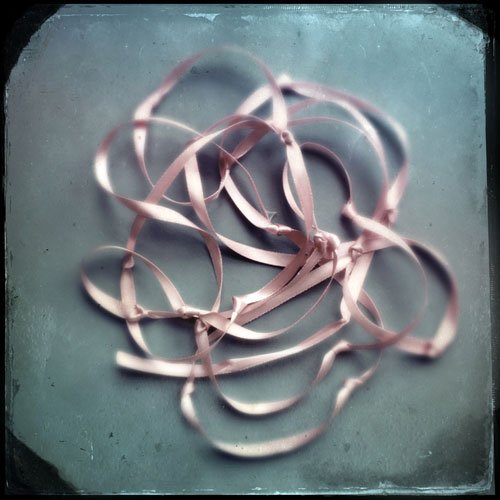 Love Knots :: Tinto 1848 // C-Type Plate // No flashBy carefully examining the originals, I determined a method to simulate them. They were 2¼ inch in diameter, so I estimated one knot about every 10cm would suffice. These knots, by the way, I discovered were referred to as ‘love knots’. Experimenting with the size of the loops, I saw that I would need to use the entire 2m on one flower, not two as I’d originally supposed.
Love Knots :: Tinto 1848 // C-Type Plate // No flashBy carefully examining the originals, I determined a method to simulate them. They were 2¼ inch in diameter, so I estimated one knot about every 10cm would suffice. These knots, by the way, I discovered were referred to as ‘love knots’. Experimenting with the size of the loops, I saw that I would need to use the entire 2m on one flower, not two as I’d originally supposed.
 Sew Easy :: Tinto 1848 // C-Type Plate // No flashOnce I had finished tying fairly loose knots along the entire length (leaving about 15cm untied at each end just in case I should require it), I began forming and sewing the loops together. (Don’t use a rusty needle as I did!)
Sew Easy :: Tinto 1848 // C-Type Plate // No flashOnce I had finished tying fairly loose knots along the entire length (leaving about 15cm untied at each end just in case I should require it), I began forming and sewing the loops together. (Don’t use a rusty needle as I did!)
 All Tied Up :: Tinto 1848 // C-Type Plate // No flashThe flower was completed with a last knot over the middle to hide the stitches.
All Tied Up :: Tinto 1848 // C-Type Plate // No flashThe flower was completed with a last knot over the middle to hide the stitches.
 Pinned :: Tinto 1848 // C-Type Plate // No flashAmongst my supplies I already had a couple of spare brooch pins, and using the extra ribbon from each end, I attached the flower to the pin and wrapped ribbon around the base. It’s a much nicer finish than the original 1920s versions, if I do say so myself. Some flapper had lazily stitched the flowers to safety pins.
Pinned :: Tinto 1848 // C-Type Plate // No flashAmongst my supplies I already had a couple of spare brooch pins, and using the extra ribbon from each end, I attached the flower to the pin and wrapped ribbon around the base. It’s a much nicer finish than the original 1920s versions, if I do say so myself. Some flapper had lazily stitched the flowers to safety pins.
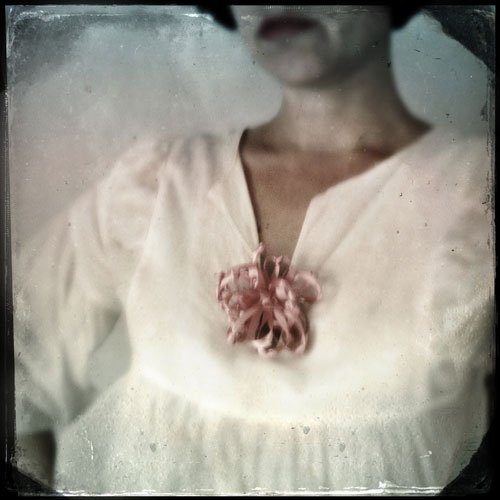 Be Flowered :: Tinto 1848 // C-Type Plate // No flashMy flower ended up a little bigger, about 10cm or 3” across, but I think they are not too shabby for a first attempt. Certainly a natural fibre ribbon would sit, and feel, much nicer too.
Be Flowered :: Tinto 1848 // C-Type Plate // No flashMy flower ended up a little bigger, about 10cm or 3” across, but I think they are not too shabby for a first attempt. Certainly a natural fibre ribbon would sit, and feel, much nicer too.
Right, back to Etsy for some legitimate late-night shopping for vintage ribbon …
Doodling Doodles
 Ice Ice Baby Arm Two, Tim Moore, 2011
Ice Ice Baby Arm Two, Tim Moore, 2011 Tim Moore hard at workTim Moore loves to embroider. And he has a very cheeky sense of humour. After completing a Bachelor of Three Dimensional Design at Brighton University, he had a brief foray in jewellery design (which made him unhappy) and then a stint graphic design. It was his love of doodling however that lead to embroidery. Forgetting his sketchpad and pens, on a long-haul flight he took to the sick bag with a sewing kit, and the rest is history.
Tim Moore hard at workTim Moore loves to embroider. And he has a very cheeky sense of humour. After completing a Bachelor of Three Dimensional Design at Brighton University, he had a brief foray in jewellery design (which made him unhappy) and then a stint graphic design. It was his love of doodling however that lead to embroidery. Forgetting his sketchpad and pens, on a long-haul flight he took to the sick bag with a sewing kit, and the rest is history.
He has an eye for the absurd, taking his inspiration from a stock of hunting, fishing and nudist magazines that tickle his fancy. His canvas of choice: vintage Sicilian or Irish linen, and he uses silk or metallic thread.
 What’s the point of that?, Tim Moore, 2007
What’s the point of that?, Tim Moore, 2007 On the piss with Steve Davis, Tim Moore, 2007
On the piss with Steve Davis, Tim Moore, 2007 Bande eccellenti del cavallo del hero, Tim Moore, 2008
Bande eccellenti del cavallo del hero, Tim Moore, 2008
‘They all come under the ridiculing eye of Moore, who likes to rub it in with his own love for puns with titles such as the Made up Fish series, which depicts fish with cosmetically enhanced eyes and lips. In the same vein, the Sew Natural series plays on the medium of sewing and the irony of sewing nudes on the very fabrics they shun. Hanging out at Lake Flacid (2010) depicts a pyramid of formation water skiers with their penises dangling from their trousers in happy but flaccid dashes of pale pink – there is variation between the penis sizes with the largest belonging to the flag waving top-rung skier.
Moore’s latest body of work, Ice Ice Baby Arm, depicts ice-skaters in compromising poses oblivious to the penises which dangle from the male’s tights. In Ice Ice Baby Arm 2 (2011) the penis, at first glace, charmingly appears to be part of the female skater’s hat. … There is also something of the utopian childhood joy associated with Moore’s depictions; after all, these are not the threatening phalluses of aggression, but playful sausage-rolls of insouciance.’ [From Tim Moore, by Gillian Serisier, Artist Profile Issue 15, 1 June 2011]
He says of his work, “I’m a dick doodler. It’s whimsy and fun. There might be some deep-rooted thing, but I don’t know. Maybe I should go and speak to someone. I just think whimsical dick drawings and dick doodles are generally fairly funny,” says Moore.
They are funny – after the first innocent perusal one blinks, then giggles. Visit Helen Gory Galerie for more.
 Ice Ice Baby Arm Four, Tim Moore, 2011
Ice Ice Baby Arm Four, Tim Moore, 2011 A Tri Dangle, Tim Moore, 2011
A Tri Dangle, Tim Moore, 2011
Knit Wit
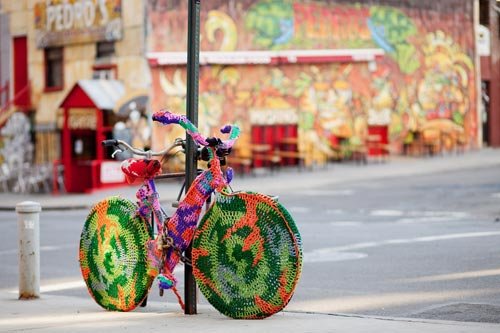 Knitting gets a twenty-first century makeover when crafty folk take to wrapping the streets with their handiwork. No object, stationary or not, is too small or too large, from trees to cars to park benches – a yarn bomber will knit with wit.
Knitting gets a twenty-first century makeover when crafty folk take to wrapping the streets with their handiwork. No object, stationary or not, is too small or too large, from trees to cars to park benches – a yarn bomber will knit with wit.
We are so used to seeing graffiti sprayed on walls, we’ve become blasé, but we can’t do that with yarn bombing just yet. It’s not flat, it’s three-dimensional and that is what’s so wonderful about it. It’s surprising, makes us laugh with astonishment, and feel all warm and fuzzy on the inside to think that we can add to the beauty of nature – or beautify the ugliness of our urban environment – with something that is colourful yet harmless. Thank you all you crazy and dedicated knitters out there!
Read more at Jafagirls.
Ikat Fascination
I really am fascinated by ikat. The designs I like most are the very bold, simple geometric patterns that use minimal colour. The most beautiful aspect of this textile is the way in which the uniquely dyed threads merge softly on the loom, creating a distinctive, subtle blur.
The thread is painstakingly dyed before it is woven. The dying process is intricate: the thread is first coated in a resist (wax), tied with pieces of fabric, then dipped into various coloured dyes. This process is performed repeatedly, resulting in an elaborate multicolour warp. On the loom, the coloured warp is woven with the undyed weft. The distribution of colour is carefully controlled to create the characteristic patterns, traditionally incorporating motifs such as tulips, pomegranates and trees.
Ikat weaving is found in many countries, including Japan, Thailand, India, Afghanistan, Greece, Morocco and Uzbekistan. In fact, the word ‘ikat’ comes from the Malay-Indonesian verb mengikat, ‘to bind, tie or wind around’.
Here is a selection of some lovely ikat fabrics to scroll through, and you can also revisit my story on Russian textiles, for more examples on antique costume constructed from ikat, as well as printed cottons.
 (Left) www.smith.edu, (right) www.ethno-textil.com
(Left) www.smith.edu, (right) www.ethno-textil.com (Left) www.blogger-index.com, (right) laurakiran.com
(Left) www.blogger-index.com, (right) laurakiran.com (Left) site.alifosterpatterns.com, (right) www.fschumacher.com
(Left) site.alifosterpatterns.com, (right) www.fschumacher.com (Left) www.classicallyb.com, (right) www.katyelliott.com
(Left) www.classicallyb.com, (right) www.katyelliott.com



